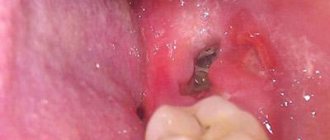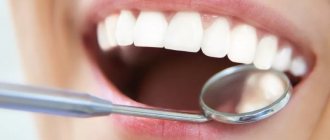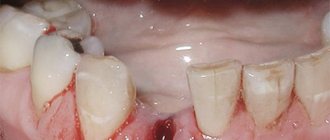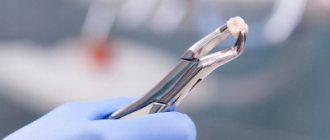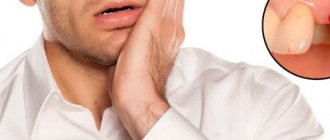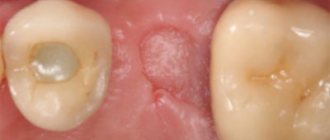Dry tooth socket: features of the disease
A dry socket appears in two cases after tooth extraction. In the first, a blood clot may fall out or dissolve, while in the second, it may not form initially (usually due to severe bleeding). On average, a similar diagnosis is made to two to five percent of people who have undergone a tooth extraction procedure, but dry socket after wisdom tooth removal is much more common. In the absence of timely treatment, the disease can progress to the stage of alveolitis, which in turn threatens the appearance of phlegmon or an abscess. What does a dry socket look like? Visually, a dry tooth socket is easy to identify: in the absence of a blood clot, part of the bone is exposed.
Symptoms of dry socket
- After 2 - 3 days, the gums begin to become inflamed and pain appears.
- As the inflammatory process develops, pain increases and manifests itself not only in the oral cavity, but also in the cervical region, as well as in the ear area.
- The appearance of an unpleasant odor and specific taste in the mouth is another characteristic symptom.
- Partial hearing loss may occur.
What is dry socket?
During the operation to remove a tooth, the mucous membrane is damaged.
After a tooth is removed, in the space where the tooth itself was located, after some bleeding, a fairly dense blood clot forms, which promotes healing of the wound. This is how physiology works, showing its protective functions and promoting the speedy independent healing of the wound.
WHAT WELL:
some unpleasant symptoms, such as slight bleeding, pain and a feeling of heat in the socket after 3-10 days, after restoration of the upper tissues completely disappear.
WHAT IS WRONG:
if the blood clot has completely disintegrated or has been washed out, then in this case the hole will become so-called. dry, exposing bone and nerves. Therefore, the appearance of a dry socket can be accompanied by severe pain. The first five days after tooth extraction are the most important, and it is during this time that the risk of dry socket is greatest.
Causes of dry socket after tooth extraction
- Smoking (especially immediately after tooth extraction).
- Poor oral hygiene over a long period of time.
- Poor blood clotting or taking blood thinners.
- Frequent rinsing of the mouth.
- Mechanical impact on the socket and soft tissue in its area.
In addition to the factors mentioned above, much depends on the extraction procedure itself: improperly performed tooth extraction contributes to a number of complications, including dry socket and alveolitis. To prevent this unpleasant phenomenon, dentists recommend limiting physical activity for a few days after tooth extraction, and also not chewing on this side of the jaw (especially hard foods). Under no circumstances should you touch the hole and the area around it with your hands or foreign objects. Bad habits (drinking alcohol and smoking) should be eliminated during healing. The doctor usually prescribes anti-inflammatory drugs for rinsing the mouth (miramistin, chlorhexidine or furatsilin), but this procedure should be carried out no more than 2 - 3 times a day.
How to speed up the healing of an extracted tooth socket and prevent its inflammation
Pulling out (or scientifically, extraction) a tooth involves inevitable trauma to the mucous membrane, so after the procedure special care for the oral cavity is required.
Otherwise, the open wound may become inflamed and then fester. We are talking about the development of alveolitis - a dangerous phenomenon that most often results from the patient’s failure to comply with doctor’s instructions. If you do not promptly heal the inflamed hole after tooth extraction, you may encounter even more serious dental problems. Later in this article we will talk in detail about what care is required after extraction, what a properly healing hole should look like, and what to do if signs of a pathological process appear. On a note! Statistics say that more often than usual, alveolitis occurs after the removal of lower molars, especially after extraction of wisdom teeth1. This is explained as follows: the distinctive anatomical features of the lower jaw create some difficulties in the work of a specialist. The bone is thicker, and it is more difficult to extract roots from it, especially if they are twisted and tangled.
Treatment methods for dry tooth socket
If you discover symptoms of a dry socket, immediately contact your dentist: in this case, you should not self-medicate, although on the Internet you can find a lot of advice on how to treat a dry socket at home. Can a dry socket heal on its own? Without therapeutic and preventive measures, the healing process is not always successful and takes longer. What kind of dry socket treatment will be carried out after tooth extraction depends on the degree of development of the inflammatory process.
| Degree of complication | Treatment method |
| Lightweight | Antiseptic and anti-inflammatory drugs available without a prescription. |
| Average | Antibacterial therapy, cleaning the hole and filling it with anti-inflammatory gel. |
| Heavy | In severe stages of the disease (cellulitis, abscess), the patient is sometimes hospitalized, and a number of measures are taken for his rehabilitation, including physical therapy and ultraviolet irradiation. |
Treatment of a dry socket after the removal of a wisdom tooth is carried out in the same way as in the case of other teeth, however, access to the area of inflammation can be complicated due to the distance of the “eight” location.
The patient himself causes the “dry socket” effect to appear.
A dry socket will definitely manifest itself if the patient does not adhere to the dentist’s recommendations after tooth extraction and willfully allows such actions as
:
- thinking that he is making his condition easier by rinsing blood clots out of the tooth socket too often and intensively;
- thinking that his tongue has healing properties, he constantly “checks” with his tongue the surrounding tissue of the pit and the pit itself inside;
- Having convinced himself that he should drink in a thin stream, he drinks everything through a straw or sips all drinks from a spoon with his lips, thereby creating a vacuum effect in the mouth;
- not giving a damn about the doctor’s strict recommendations, he ignores the restrictions, and at least a little, at least a little, engages in heavy physical labor or sports during the rehabilitation period after removal (oh, like, look how cool I am!).
Dry socket syndrome in wisdom teeth
The concept of dry socket syndrome refers to the wisdom tooth. In the case of a wisdom tooth, this is practically alveolitis. It can also occur in this area, especially in the area of the lower wisdom teeth due to the fact that as a result of swallowing, as a result of opening the mouth, the muscles tense, which aggravate the occurrence of alveolitis.
What can dry socket syndrome lead to and what to do?
Dry socket syndrome can lead to very severe pain that radiates to the temple and ear. This is a very great torment: a person cannot, even if he is not sensitive, he cannot tolerate it, he will definitely take painkillers 4-5 or 6 tablets. And as a result of this, he will still go to the dentist. This dry socket condition will not go away on its own. It can only get worse - up to inflammation of the jaw, alveolitis. There can be very disastrous consequences.
How long does it take for a dry socket to heal?
Many people are interested in the question of how long it takes for a dry socket to heal. In the absence of complications, the wound heals in 5 - 7 days, and within a month the hole is filled with epithelial tissue. If you have dry socket, the healing process may take longer than two weeks (with proper treatment, of course). As already mentioned, extensive inflammation may occur and even require surgical hospitalization of the patient: in this case, the healing of the dry socket may be very delayed.
Indications
In addition to the above cases, curettage of the tooth socket is also prescribed in case of detection of an infectious lesion of the tissue structure, diagnosing alveolitis or the effect of a dry cavity. Typical symptoms that necessitate medical intervention include:
- Pain syndrome that persists for more than 3-4 days after surgery.
- Increased temperature, inflammation of the gums in the area of removal, acute reaction to chewing load.
Negative symptoms are typical only for the first 48 hours, and are caused by the body’s natural reaction to the changes that have occurred. If severe discomfort persists, it is recommended to immediately consult your doctor and undergo a re-examination.
Possible complications
If serious inflammatory processes arise in the gum, then after surgery it may change its color to bright red, blue or black. If all this is accompanied by pain, the gums become loose to the touch, and purulent discharge appears, then you should immediately contact the clinic for an examination.
The most common complications include the appearance of cysts. They are small formations containing a small amount of clear liquid inside. If you seek help in a timely manner, treatment may be limited to drug therapy.
Other common pathological processes that occur against the background of gum inflammation include alveolitis, periostitis and gumboil. Flux appears due to infection in the periosteum tissue. Alveolitis manifests itself in the form of redness and significant swelling in the wound area. The patient may complain of acute pain, the appearance of pus, fever and poor health. Also, the pathology is often accompanied by bleeding, which cannot be treated with improvised means.
What can you do
The first thing to remember: when the very first symptoms of an incipient inflammatory process in the oral cavity appear, it is important to contact a medical facility as quickly as possible. It is almost impossible to independently identify the cause and stage of development of the pathology, and treatment with folk remedies can lead to more serious consequences.
Inflammation at the initial stage is easily eliminated by rinsing. For this purpose, certain medicinal herbs may be prescribed, for example, thyme, sage or oak bark. They are ideal for regular rinsing, reduce pain and swelling, and have a powerful antibacterial effect.
The doctor may also prescribe analgesics, for example, Dolaren or Ketanov. Unfortunately, when the inflammatory process enters an advanced stage, such therapy will not bring the desired result. In this case, the dentist may prescribe washing the infected hole and treating it with medicinal applications. General recommendations include preventive rinsing of the mouth with antiseptics at home, for example, Chlorhexidine solution. It is also best to temporarily stop taking blood thinning medications, smoking, and drinking any alcoholic beverages.
previous post
How to make teeth whiter?
next entry
Indications for use
If a tooth is removed with a cyst or there is periodontitis, then the socket is cleaned immediately. In other cases, curettage is required for infection of soft tissues, dry socket effect, remaining tooth fragments, alveolitis.
You should consult a doctor if you have the following symptoms:
- acute or persistent pain that does not go away 3 or 4 days after surgery;
- gums become inflamed;
- temperature rises;
- the pain intensifies when eating.
Dry socket syndrome
A blood clot forms in the wound at the site of the former tooth. A blood clot may fall out if the tampon is removed early or for another reason. As a result, the healing process is disrupted, allowing access to deep tissues, nerve endings, and bone. The patient experiences severe pain. It is urgent to carry out surgical cleaning, otherwise the inflammatory processes will spread to the bone.
Curettage for alveolitis
Another complication of tooth extraction is alveolitis. Even if the outer edges of the wound are healed, but there is severe pain and swelling of the gums, this may indicate post-traumatic inflammation of the alveoli - the depression in the jaw bone. Delay can lead to the development of osteomyelitis.
Types and methods
In accordance with the accepted classification, there are two forms of curettage of the socket of an extracted tooth:
- Closed method - used in the early stages of periodontitis and periodontal disease, in cases where the pocket depth is less than 5 mm. The complexity of the procedure is due to the fact that medical manipulations are carried out almost blindly, since it is not possible to look under the gums.
- The open method is a surgical operation prescribed when diagnosing a depression of more than 5 mm. It involves excision and separation of inflamed tissue, followed by treatment of the formed cavity with special instruments and disinfectant solutions.
Antiseptic treatment is a prerequisite to prevent the development of an inflammatory process. Drugs placed in the hole stop negative manifestations and prevent the spread of infection to adjacent healthy elements. The healing process and change of bandage are controlled by a doctor - if there are no problematic factors, the sutures are removed ten days after cleaning.
Advantages and disadvantages
Competent and timely implementation of the curettage protocol contributes to the accelerated restoration of tissue structure. If there are reasons for cleaning, it is not recommended to neglect the procedure, since the consequences of the development of a pathological condition require longer and more expensive treatment.
Among the shortcomings, it is worth noting only the strict requirements, compliance with which is a prerequisite in the postoperative phase. Thus, medical prescriptions exclude direct contact with the area that has undergone surgical intervention during the process of brushing teeth. The consumption of hot food is limited, it is recommended to give up alcohol and smoking for a while. To relieve inflammation and swelling, cold compresses should be applied periodically.
Stages of the procedure
During curettage, purulent and serous contents, dental fragments, and necrotic masses are removed. Cleaning is carried out in stages and involves the following sequence of actions:
- Injection of anesthetic into the intervention area;
- Washing out blood clots and purulent masses from the cavity with a disinfectant solution;
- Cleaning the hole with a curettage spoon from tooth fragments and damaged tissues;
- Repeated antiseptic treatment;
- Application of the drug and protective bandage.
If infection is present, additional antibacterial drugs are prescribed. After 1 or 2 days, the injured tissues begin to recover, redness and swelling subside.
Ways to stop ichor after tooth extraction
After tooth extraction, the dentist carries out a number of measures to stop bleeding:
- installation of a tampon impregnated with special medicinal substances;
- application of a hemostatic sponge;
- prescribing medications for better blood clotting;
- suturing the damaged area.
During normal tooth extraction, to stop bleeding, it is enough to use a tampon, which is held pressed for thirty minutes. If complications arise to stop bleeding, more radical measures are used in the form of suturing; this technique is used in case of damage to the artery. When small vessels are damaged, coagulation (cauterization of ruptured vessels) is most often used. After removing a wisdom tooth or several teeth located nearby, additional sutures are applied to prevent the development of complications.
If it is impossible to quickly determine the cause of bleeding, injections with substances are administered to stop the bleeding. Two methods are used for this:
- Intramuscular injection of Vikasol solution one percent;
- Intravenous injection of a solution of the following components: ten percent calcium chloride solution, calcium gluconate.
If bleeding occurs at home, you need to prepare a small tampon or sterile bandage. Place on the damaged area, after thoroughly washing your hands, and eat for a period of forty minutes. If this method does not help stop the ichor, it is necessary to prepare a new tampon, which must be moistened with a three percent solution of hydrogen peroxide. This solution has a clotting effect on the blood. Apply the tampon for five to ten minutes.
If the bleeding cannot be stopped, you should consult a doctor as soon as possible.
